via Fast Company
BYÂ EKATERINA WALTERÂ AUGUST 28, 2012
Blog posts became Facebook updates and Tumblr posts, which shrunk to Tweets and finally to Instagram or Pinterest. Here’s how smart brands are navigating the new visual social-media era.

Social media sites like Facebook, Instagram, and Pinterest have ushered in visual marketing as the breakout trend for 2012. When it comes to their products, businesses are learning to show, not tell, and visual content sites are fueling our desire for beautiful photography and sensational design. Two years ago, marketers were spreading the maxim that “content is king,” but now, it seems, “a picture really is worth a thousand words.”
“Blogs were one of the earliest forms of social networking where people were writing 1,000 words,” says Dr. William J. Ward, Social Media professor at Syracuse University. “When we moved to status updates on Facebook, our posts became shorter. Then micro-blogs like Twitter came along and shortened our updates to 140 characters. Now we are even skipping words altogether and moving towards more visual communication with social-sharing sites like Pinterest.”
This trend toward the visual is also influenced by the shifting habits of technology users. As more people engage with social media via smartphones, they’re discovering that taking a picture “on the go” using a high-resolution phone is much less tedious than typing out a status update on a two-inch keyboard.
A 2012 study by ROI Research found that when users engage with friends on social media sites, it’s the pictures they took that are enjoyed the most. Forty-four percent of respondents are more likely to engage with brands if they post pictures than any other media. Pictures have become one of our default modes of sorting and understanding the vast amounts of information we’re exposed to every day.
Detavio Samuals is the EVP and Director of Client Services at GlobalHue, one of the nation’s top market advertising agencies. He explains that pictures are a bit like movie trailers for written content–they provide a snippet of what an article, brand, site or other piece of content is about, so that you can quickly decide if it’s what you wanted or not.
“Pictures have also become a short form way of communicating lots of information quickly and succinctly,” says Samuals. “The need for publishers to get to the point quicker than ever came about as humans became more pressed for time and content became more infinite. For publishers, it was evolve or risk losing their audience, and the only thing shorter than a tweet or post is a picture.”
So what does all this visual stimulation mean for brands?
Fashion designer Kahri-Anne Kerr uses visual social media sites like Pinterest and Facebook to market her Kahri collection. In the fashion world, visual fantasy sells product, as customers need to see the cut of a garment on a model and feel as though they could make that item work in their own wardrobe. “When I post pictures on Facebook, they get the most feedback of all my posts,” says Kahri. Visual media is a great way to share more about what inspires the designs, as well as linking to your online store and straight product shots.”
“I am just getting into Instagram, which I use to give a personal look at the person behind the label by taking shots around my studio and in my everyday life.”
Designer paper/analog brand Moleskine has harnessed the power of visual media to create one of the world’s most active, prolific, and creative online communities. Their visual content strategy focuses on user-generated content: They create large-scale projects that users participate in by posting their own images and videos.
A popular campaign called What’s In Your Bag? had users update pictures of the contents of their bags into a Facebook album. The project generated thousands of likes and comments as readers looked at the contents of other bags (which included Moleskine notebooks, naturally), and shared photos with their friends.
Inspiring fans to create and spread images, customize their notebooks, organize online competitions, and otherwise engage with the brand on a creative level has set Moleskine apart in its highly specialized market.
Search engines now rank content based on social conversations and sharing, not just websites alone. Brands can use visual content on their social media to increase engagement and inspire sharing and viral marketing. The rise of platforms like Pinterest and Instagram, and Facebook’s multimillion-dollar acquisition of the latter, shows how visual content is becoming an increasingly important force for communication online.
Brands that can rock visual media will find themselves market leaders.
–Ekaterina Walter is Intel’s social media strategist. Follow her @ekaterina.



